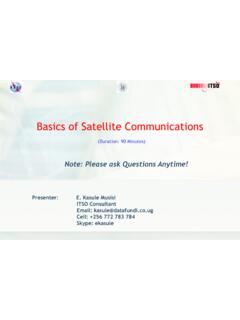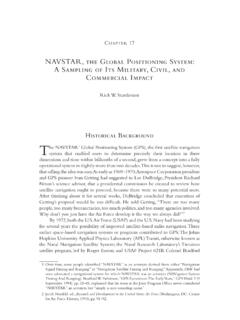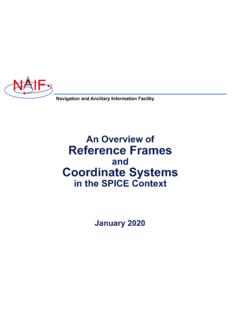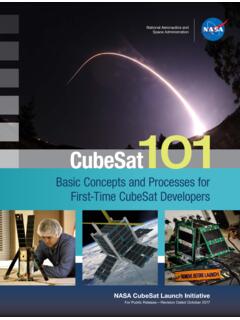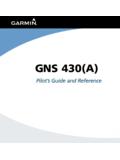Transcription of Introduction to the Satellite Industry
1 Introduction to the Satellite IndustryIntroduction:Satellites are Essential to our Modern Society Continuously delivering Earth Observation; Position, navigation , Timing; and Communications to all Establishing global leadership in space network innovations Assuring lynchpin services to protect our nation Serving as an Incubator for Next-Gen Technology Providing ubiquitous connectivity and information services, daily and in time of disaster Broadband, Media, and Entertainment in every formatBasics: Satellite SegmentMedium earth orbit (MEO) satellites are located between LEO and GEO satellites at 6,300 to 12,500 miles. 10-18 are required for continuous global coverage. Lower latency (150 ms).Low earth orbit (LEO) satellites are closest to users (300-1200 miles) but require 40-70 satellites for full coverage. Low latency (10 ms).
2 Geosynchronous (GSO) Satellite orbit (22,236 miles) rotates at the same speed as the Earth s rotation. Three satellites can provide global coverage. 300 mslatency, which can support most Geostationary Equatorial Orbit (GEO)is a special case of GSO in which satellites circle the Earth above the Equator and appear to be stationary over a fixed position. Basics: Key Satellite Network Elements Space Segment Satellites in geostationary orbit or non-geostationary orbit (medium earth orbit, or low earth orbit) Ground Segment Telemetry, Tracking, and Control (TT&C): used to fly the Satellite Gateway/Hub: used to manage communications User Terminals: devices used to connect the customer to the Satellite network Can be receive-only or transmit; mobile or fixed; a dish, a laptop, or a handheld, depending on the application, site, : Unique Attributes of Satellites Large geographic coverage interconnecting widely distributed networks providing broadcasting services over a country, region, or entire hemisphere providing last mile connectivity for telecom services, broadband and video services Instant infrastructure always-on network redundancy emergency connectivity Supporting Mobility voice, data, broadband, or mobile video air, land, or sea Wide Area Observation Collecting data or large swaths over land and ocean Diverse sensor information for varying types of information5 Satellites provide a variety of mobile and fixed communications services6 Image credit.
3 ESOAThe International Telecommunication Union (ITU) is the venue for registering GEO orbital slots (via companies governments) and has allocated specific frequency ranges used by commercial satellites globally: Basics:Frequency AssignmentVHF/UHF30 MHz-1 GHzTelemetry, Tracking, and Command (TT&C), Internet of Things applications, Earth Exploration Satellite Service (EESS)L-band1-2 GHzMobile services (MSS), RadionavigationSatellite Services (RNSS)S-band2 GHzMSS, EESS, Satellite radio (DARS), TT& GHzFixed Satellite services (FSS), RNSS, TT&CX-band8 12 GHzEESS, Military/ Satellite imagery and GHzFAA, Satellite TV/broadcast, FSS broadband , TT& GHz 31 GHzFSS broadband and inter- Satellite links, EESS, TT&CQ/V-band33-75 GHzFSS, inter- Satellite links, EESSW-band75-100 GHzFSS, MSS, EESS7 Fixed Satellite Services (FSS)
4 * network equipment and consumer terminals Wide range of sizes and costs Teleports with many Earth Stations VSAT dishes for private corporate networks and credit card Consumer terminals for high-speed broadband at lower cost and easier install May be stationary, transportable or in motion/on a mobile platform (aircraft, ship, vehicle) Mobile Satellite Services (MSS)* terminals Provide voice or data services Form factors vary from business card-size modems to laptop-size receivers and sleeves to convert mobile phones GNSS equipment and chipsets Provide Position, navigation , and Timing information to either standalone devices ( , Garmin) or integrated into other devices ( , cell phones)*FSS and MSS defined by frequency, and no longer defined by whether or not the services are mobileSatellite Ground Equipment8 May be stationary, transportable (newsgathering), or in motion/on a mobile platform (vehicle, aircraft, vessel) Satellite Communications Innovation Trends High-Throughput Satellites utilize spot beam technology and frequency reuse to increase capacity more than 20x Dynamic spectrum use allows for reallocation of spectrum to most-needed areas Flat panel antennas are being developed to enhance communications on the move Constellations of tens to thousands of smaller NGSO satellites will provide low-latency broadband worldwide9 Image credit: ViasatSatellite Imagery Innovation Trends Satellites can image the Earth in many different ways: Visible: natural color or black & white images Infrared.
5 Capturing wavelengths the human eye can t see; this can see through smoke, determine vegetation health, identify materials, etc. Radar: active Satellite sensors send radar signals to Earth and measure how long it takes to come back, creating the image; these satellites work in all weather conditions and during the day and night. Applications: Defense and intelligence: mission planning, situational awareness Humanitarian Aid and Disaster Response (HADR) Commercial: Maps for autonomous vehicles and infrastructure planning and monitoring Technological advances: Resolution: satellites collect imagery as sharp as 30 cm, leading the world s capabilities Revisit: satellites can increasingly monitor the world by imaging a single location multiple times within a single day. Access: Imagery is now more easily obtained. Combining cloud storage with cloud computing allows users to leverage AI and machine learning to extract insights from imagery at Satellite captures North Korean missile launch, 5/4/19 Maxar s WorldView-3 Satellite images in 30 cm Remote Sensing Trends Types of sensors: Signal occultation / reflectometry / altimetry Radio frequency detection Applications: Accurate commercial weather forecasts Tracking illegal ship activity on the ocean Aviation safety M2M/IoT communications Technological Advances: Advanced data analytics Geolocation of RF signals Dramatic cost and latency reduction 11 HawkEye 360 s geolocation of VHF-16 maritime distress signals near the Auckland Maritime AIS and Spire Aviation ADS-B data.
6 Mobile Satellite Services grew 3% from 2017-2018 MSS operators continued increasing penetration into the IoTmarkets LEO MSS operators fully deployed new generation satellites GEO MSS operators bundle MSS with managed FSS and broadband services Fixed Satellite Services: managed network service 7% revenue growth from 2017-2018, offset decline in transponder leasing Continued expansion in in-flight connectivity and other mobility applications Operators providing consumer broadband also drive the mobility application expansion Deployment of additional high-throughput Satellite (HTS) capacity14 Satellite Services Findings:Fixed and Mobile Services27%29%13%10%7%7%5%6%7%11%11%14%7 %12%22%2%7%Space Observation (<1%)Non-Profit Communications (<1%)13 The Satellite Network in ContextOperational Satellites by Function and Mass ClassCommercial CommunicationsGovernment CommunicationsRemote SensingMilitary SurveillanceTotal OperationalSatellites2,100R&DScientificN avigationExtra Heavy (7,000+ kg) (1%)Active Satellites by Mass Class (total mass ~3,300MT)Nano(1-10 kg)Intermediate(2,500-4,200 kg)Medium(1,200-2,500 kg)Micro(10-200 kg)Small (600-1,200 kg)Large(4,200-5,400 kg)Mini (200-600 kg)Heavy (5,400-7,000 kg)Unknown/ClassifiedPico ( kg) Estimated as of December 31, 2018 Number of satellites increased 67% over 5 years (from 1,261 in 2014)
7 Satellites launched 2014 2018 increased 243% over previous 5 years Average 210/year Due mostly to small/very small satellites in LEO (<1,200 kg) Total Satellite mass in orbit about 3,300 metric tons Average operational lives of larger (mostly communications) satellites becoming longer, exceeding 15 years; 272 active satellites launched before 2003 558 active satellites in GEO (27 more than in 2017, mostly providing communications services) 2,100 satellites operated by entities from 68 countries (some in regional consortia) Cumulatively, organizations from 86 countries have deployed at least one Satellite since 1957 entities operate 849 satellites, some in partnership with other nations$ $ $ $ $ $0$50$100$150$200$250$ GrowthGrowth RateGlobal Satellite Industry Revenues: Portion Average yearly market share$ Billions2%3%3%7%3%2%2%4%4%3%2%4%2%9%4%of globalindustry43% Satellite IndustryTotal:$ :$ :$ :$.
8 $ $ $ $ $ $ $ $ $ $ $ $0$2$4$6$8$10$12$14$16$18$20201420152016 20172018 Growth RateSatellite Manufacturing Revenues$ Billions10%26%1%1%-13%Total$ $ $ $ $ States Worldwide 2018 revenues totaled $ In 2018, share of global revenues was 59%, in line with 57% in 2017 NOTE: Satellite manufacturing revenues are recorded in the year of Satellite launch. Do not include satellites built by governments or universities. Data based on unclassified sources. Average: $ 53 13 5 17 5 2 2 1 Satellite Launch Industry Findings2018 Commercially Procured Satellite Launches by Orbit93 TotalLEOGEOEXT162018 Commercially Procured Satellite Launches by Vehicle27 TotalFalcon 9 Atlas VDelta IVDelta IIElectron $ revenues from commercially procured Satellite launches worldwide; 34% growth Record number of commercially procured Satellite launches worldwide (93 higher than in any previous years; 64 in 2017) had largest share (37%) of commercially procured launch revenues.
9 27 launches by providers (23 in 2017) Record year for Chinese launch providers 39, all captive except 1 internationally competed launch (previous maximum 22 launches in 2016) Continuing trends Launches of Government satellites generated 23% of global launch revenues Government customers worldwide remained the revenue driver (growing to 71%, from 55% in 2017), reflecting increased launch activity in China European provider Arianespace maintaining launch cadence No commercial launches from Russian providers, continuing declineMEO72,708 18,164 54,906 71,563 Employment ImpactSource: analysis of data from Bureau of Labor Statistics (BLS).17 In 3Q 2018, Satellite Industry employment in the was 217,341 Private sector only Estimated across multiple NAICS codes 2% increase over same time in 2017 Total Satellite Industry Employment(3Q 2018)217,341 Satellite ServicesLaunch IndustryGround EquipmentSatellite ManufacturingThe Satellite Industry in Context$360 BGlobal SpaceEconomyNon-SatelliteSpace Industry $ $ Equipment$ $ (77% of Space Economy)Telecommunications Television Telephone Broadband Aviation Maritime Road and RailRemote Sensing Agriculture Change Detection Disaster Mitigation Meteorology Resources Earth ScienceSpace ScienceNational SecurityConsumer Equipment Sat TV, radio, and broadband equipment GNSS stand-alone units & in-vehicle systems GNSS chipsets (beginning with the 2017 report)
10 NetworkEquipment Gateways VSATs NOCs SNG equipment3%Growth2017 20183%Growth2017 2018* Includes government civil and military space spending by 70 countries and international organizations (ESA) using published data. ** Includes commercial cargo missions to ISS and other human spaceflight projects, about $2 BAcronyms: Network operations centers (NOCs), Satellite news gathering (SNG), very small aperture terminal (VSAT) equipment, global navigation Satellite systems (GNSS)18 Government SpaceBudgets*CommercialHumanSpaceflight* * Satellite ManufacturingLaunch Industry13 Satellite TV Services Satellite TV services (DBS/DTH) declined 3%, accounted for 74% of all Satellite services revenues; 92% of consumer revenues 220M+ Satellite pay-TVsubscribers worldwide (plus 190M+ free-to-air Satellite TV homes) in 2018 Subscribers and revenue declining in the Lower per-user revenues combined with growing or flat subscriber numbers outside 38% of global revenues attributed to Number of Ultra-HD channels growing slowly, around 1% of total global TV channels HD channels about 30% of all TV channels Contributing to slower demand for Satellite capacity: improving compression technologies.
